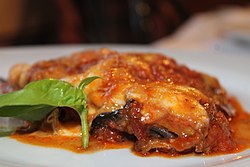Top Qs
Timeline
Chat
Perspective
Parmigiana
Italian dish of eggplant with cheese and tomato sauce From Wikipedia, the free encyclopedia
Remove ads
Parmigiana (/ˌpɑːrmɪˈdʒɑːnə, -ˈʒɑː-/, Italian: [parmiˈdʒaːna]), also called parmigiana di melanzane (Italian: [parmiˈdʒaːna di melanˈdzaːne; -ˈtsaːne]), melanzane alla parmigiana (Italian: [melanˈdzaːne; -ˈtsaːne ˌalla parmiˈdʒaːna]) or, in the United States and Canada, eggplant parmesan, is an Italian dish made with fried, sliced eggplant layered with Parmesan cheese and tomato sauce, then baked.[1][2][3][4] The origin of the dish is claimed by the regions of Sicily, Campania, and Emilia-Romagna.
Remove ads
History
Summarize
Perspective
There are several theories about the origin of the dish. Most frequently its invention is attributed to either Campania, Sicily or Parma, in Emilia-Romagna.[5][6] The case for Parma is that parmigiana refers to Parma and because Parmesan cheese is produced there. Sicilian food writers have several different explanations for a Sicilian origin. According to author Pino Correnti, the word parmigiana derives from the Sicilian word for damigiana, a wicker sleeve used both for wine bottles and the hot casserole in which the dish would be prepared and served. Authors Mary Taylor Simeti, Vincent Schiavelli, Franca Colonna Romano Apostolo, and several others write that the name derives from the Sicilian word for 'louver', palmigiana or parmiciana; the angled horizontal slats of a louver would resemble the layering of eggplant slices in the dish.[7][8]
Wright traces the origin of parmigiana to Naples. The ancestor of the modern dish appears in Vincenzo Corrado's cookbook Il cuoco galante from 1786. His recipe described eggplant seasoned with butter, herbs, cinnamon, other spices, and grated Parmesan cheese, which was then covered with a cream sauce of egg yolks before being baked in an oven. The modern version with Parmesan and tomato ragù as key ingredients appears several years later in Ippolito Cavalcanti's cookbook Cucina teorico-pratica, which was published in Naples in 1837. According to Wright, this suggests that the dish evolved in Naples during this time frame, which coincided with the increasing popularity of the tomato in Italian cuisine.[9][10] Author Marlena Spieler agrees with a Neapolitan origin of the dish for the same reasons.[11]
Remove ads
Varieties
Summarize
Perspective
Italy
This section needs expansion. You can help by adding to it. (March 2025) |
This section needs additional citations for verification. (March 2025) |
In Cosenza, parmigiana is prepared with fried zucchini and baked eggplants. It is typically made in layers with grated fresh mozzarella and grated Parmesan cheese.[citation needed]
In Naples, parmigiana is also prepared using zucchini or artichokes in place of eggplants.[12]
Outside Italy
United States and Canada
In the United States and Canada, chicken parmesan and veal parmigiana are frequently served as a main course, often with a side of pasta. The alternative anglicization parmesan is sometimes used instead, and the abbreviated form parm is common. The use of meats as an alternate to eggplant originated in the United States, where it was influenced by similar Italian dishes. A similar veal dish is known in Italian as cotoletta alla bolognese, which excludes tomato sauce but includes melted Parmesan cheese and prosciutto.[13]
Australia
Chicken parmigiana is also a common dish in Australia and is often served with a side of chips or salad. In Australia, where the name is often shortened to parma[14] or parmi,[15] it may also contain a variety of toppings, including sliced ham or bacon.[16]
South America
In Argentina, Brazil, Chile, and neighbouring countries, veal or chicken parmigiana is topped with ham and served with French fries or rice. It is known as milanesa a la napolitana.[17][18][19][20][21] If the dish is topped with a fried egg, it is known as milanesa a caballo, but omits the tomato sauce.[22][23]
England
In England, parmo uses either pork or chicken topped with béchamel sauce instead of tomato sauce and sometimes topped with other ingredients.[24]
Remove ads
See also
![]() Media related to Parmigiana at Wikimedia Commons
Media related to Parmigiana at Wikimedia Commons
References
Wikiwand - on
Seamless Wikipedia browsing. On steroids.
Remove ads

